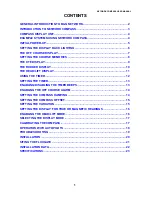
5. The Downwind Leg
While sailing dead downwind, it is often difficult to determine when the wind has
shifted and in which direction. Unlike upwind, most people do not pay attention to
compass numbers while going downwind. To further complicate things, most people
don't sail dead downwind anyway, they usually keep around 30 degrees off the appar-
ent wind in order to keep their boatspeed up and increase their VMG toward the mark.
To help keep track of which jibe to be on, one of our customers suggests the following:
Push the crs button to get into
Off-Course Mode
. Now point your boat at the leeward
mark (or the rhumb line if you can't see the mark), and press the crs button again to
lock onto that number. Now just go back to sailing as you normally do and keep the
windex at 30° off the apparent wind. The objective is to keep pointed close to the mark
and still keep your boat speed up by staying at 30 apparent. You as helmsman do your
part and keep an eye on the wind, the tactician should watch the Sailcomp display. If
you start veering off too far, he will begin to see more and more segments on the upper
part of the display. When this happens, and you are still on the wind angle you want,
it means that there has been a windshift. You now are heading farther away from the
mark just to keep the same wind angle that you had before. All other things being
equal (like wind speed and boat speed), you should jibe now so that you will be point-
ed more at the mark and still be able to maintain your nice 30 degree apparent wind
angle.
To put it simply, keep your boat pointed at the mark by jibing so as to minimize the
number of segments on the off-course indicator.
6. The Second Upwind Leg
When you get to the bottom mark, you will want to get back into the
Head/Lift Mode
.
As soon as you round the leeward mark and start sailing upwind, there is usually
enough going on so that it is difficult to remember what your averages were on the last
beat. Yet this is precisely the critical moment when you need to know whether or not
to tack - to get into phase for the next beat. To solve this problem, just push either the
port or stbd button once. This tells the Sailcomp that you are now going up-wind
again and want to know if you are being headed or lifted. Both the starboard and port
tack averages are then recalled from memory and you are back in business.
If after a while, you feel that you want to reset the averages, steer to the desired com-
pass heading and push the appropriate button. Once the display is in Head/Lift
Mode, each subsequent push to either the port or stbd button will reset the averages.
35
RACING WITH THE SAILCOMP






























